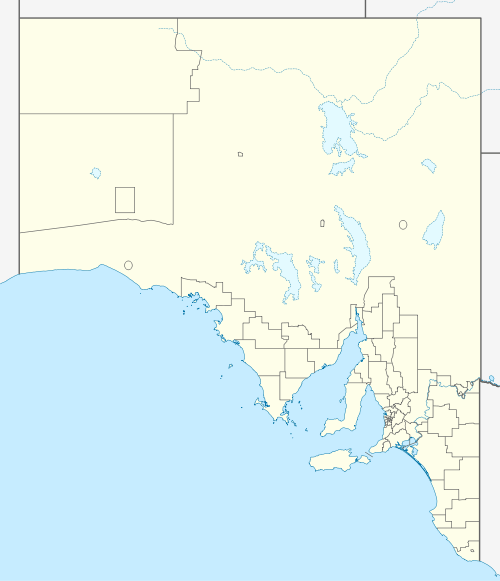Poonindie, South Australia
Poonindie is a small township near Port Lincoln on the Eyre Peninsula, South Australia. The land upon which it sits was originally the land of the Barngarla people.[7]
| Poonindie South Australia | |||||||||||||||
|---|---|---|---|---|---|---|---|---|---|---|---|---|---|---|---|
 Poonindie | |||||||||||||||
| Coordinates | 34.58126250°S 135.88101325°E | ||||||||||||||
| Established | 1850[1] | ||||||||||||||
| Postcode(s) | 5607[2] | ||||||||||||||
| Time zone | ACST (UTC+9:30) | ||||||||||||||
| • Summer (DST) | ACST (UTC+10:30) | ||||||||||||||
| Location |
| ||||||||||||||
| LGA(s) | District Council of Lower Eyre Peninsula[1] | ||||||||||||||
| Region | Eyre Western[3] | ||||||||||||||
| County | Flinders[3] | ||||||||||||||
| State electorate(s) | Flinders[4] | ||||||||||||||
| Federal Division(s) | Grey[5] | ||||||||||||||
| |||||||||||||||
| |||||||||||||||
| Footnotes | Location[2] Climate[6] Adjoining localities[1] | ||||||||||||||
Poonindie Mission was established as a mission for Aboriginal people in South Australia in 1850, at the instigation of the first Archdeacon of Adelaide, Mathew Hale, who also served as superintendent for several years. St Matthew's church, built in 1854-55 and originally intended to be the school, served both the mission and the local community. It survives and remains in use today. Hale ran the Aboriginal Training Institution at the mission.[8] His friend, the Anglican Archbishop of Adelaide, Augustus Short, visited the mission, which prospered.
The mission closed after 44 years, after which the land was divided and sold, with just St Matthew's and a small area of land remaining the property of the Anglican Church. 300 acres (120 ha) of land was became an Aboriginal reserve when the Mission closed in 1894.[8] Most of the residents were moved to Point Pearce and Point McLeay missions, while others moved to the nearby Aboriginal reserve,[9] but a small number of residents remained on the mission site until the 1910s.[10]
The institution is named in the Bringing Them Home report, as one which housed Indigenous children forcibly removed from their parents and thus creating the Stolen Generations.[11]
The former reserve is now an Aboriginal self-managed Aboriginal community called Akenta, run by Akenta Incorporated.[12][7][7]
Pooonindie Uniting Church lies to the north of the township.[13]
Heritage listings
Poonindie has a number of sites associated with the former mission listed on the South Australian Heritage Register, including:
- Poonindie Mission Bakehouse Complex and Well[14]
- Poonindie Mission Superintendent's Residence[15]
- Poonindie Cemetery[16]
- Poonindie Mission Schoolhouse[17]
- St Matthew's Anglican Church[18]
See also
- Eyre Peninsula bushfire
Other 19th century Aboriginal missions in SA
- Killalpaninna
- Koonibba
- Point McLeay
- Point Pearce
References
- "Search result for "Poonindie (Locality Bounded)" (Record no SA0056410)". Department of Planning, Transport and Infrastructure. Archived from the original on 12 October 2016. Retrieved 7 November 2015.
- "Poonindie, South Australia". Postcodes Australia. Retrieved 24 June 2016.
- "Search results for "Poonindie LOCB" with the following datasets selected - 'Suburbs and Localities', 'SA Government Regions' and 'Counties'". Location SA Map viewer. Government of South Australia. Retrieved 22 December 2017.
- "District of Flinders Background Profile". Electoral Commission SA. Retrieved 9 September 2015.
- "Federal electoral division of Grey" (PDF). Australian Electoral Commission. Retrieved 24 July 2015.
- "Monthly climate statistics: Summary statistics NORTH SHIELDS (PORT LINCOLN AWS)". Commonwealth of Australia , Bureau of Meteorology. Retrieved 23 March 2016.
- "Poonindie" (photo). State Library of South Australia. Retrieved 6 February 2020.
View of Poonindie with Aboriginal men, women and children in foreground. Akenta, as it is now known is a small township near Port Lincoln. The land belongs to the Barngarla people. The mission has been converted to a small homeland
- "Poonindie Church". Saint Matthew's Anglican Church Poonindie. Retrieved 9 February 2020.
- "Aboriginal missions in South Australia: Poonindie". LibGuides at State Library of South Australia. 12 June 2012. Retrieved 8 February 2020.
- "Poonindie Mission - Summary". Find & Connect. 15 January 2019. Retrieved 9 February 2020.
- "Chapter 8 South Australia". Bringing Them Home. 1995. Retrieved 6 March 2020.
- "Aboriginal Communities". Council of Aboriginal Elders of SA Inc. Retrieved 6 November 2015.
- "Poonindie". Google Maps. Retrieved 8 February 2020.
- "Former Bakehouse Complex & Well, former Poonindie Mission". South Australian Heritage Register. Department of Environment, Water and Natural Resources. Archived from the original on 16 February 2016. Retrieved 11 February 2016.
- "Former Superintendent's Residence, former Poonindie Mission". South Australian Heritage Register. Department of Environment, Water and Natural Resources. Archived from the original on 16 February 2016. Retrieved 11 February 2016.
- "Former Poonindie Mission Cemetery". South Australian Heritage Register. Department of Environment, Water and Natural Resources. Archived from the original on 16 February 2016. Retrieved 11 February 2016.
- "Former Schoolhouse (supposed), former Poonindie Mission". South Australian Heritage Register. Department of Environment, Water and Natural Resources. Archived from the original on 16 February 2016. Retrieved 11 February 2016.
- "St Matthew's Anglican Church, former Poonindie Mission". South Australian Heritage Register. Department of Environment, Water and Natural Resources. Archived from the original on 16 February 2016. Retrieved 11 February 2016.
Further reading
- "Aboriginal missions in South Australia: Poonindie". LibGuides at State Library of South Australia. 12 June 2012.